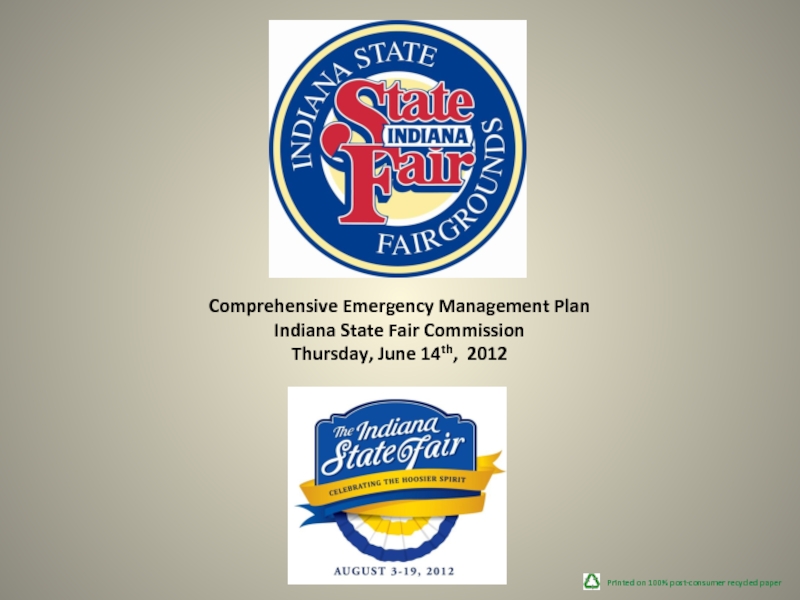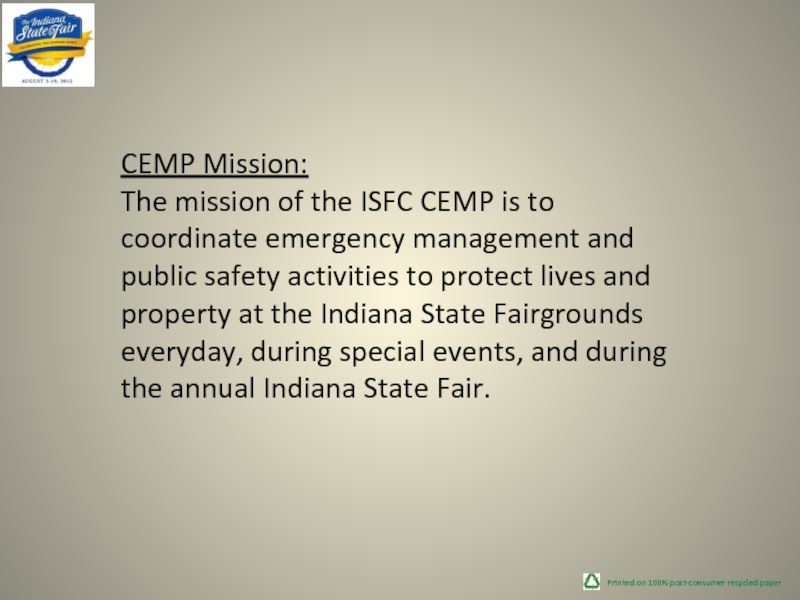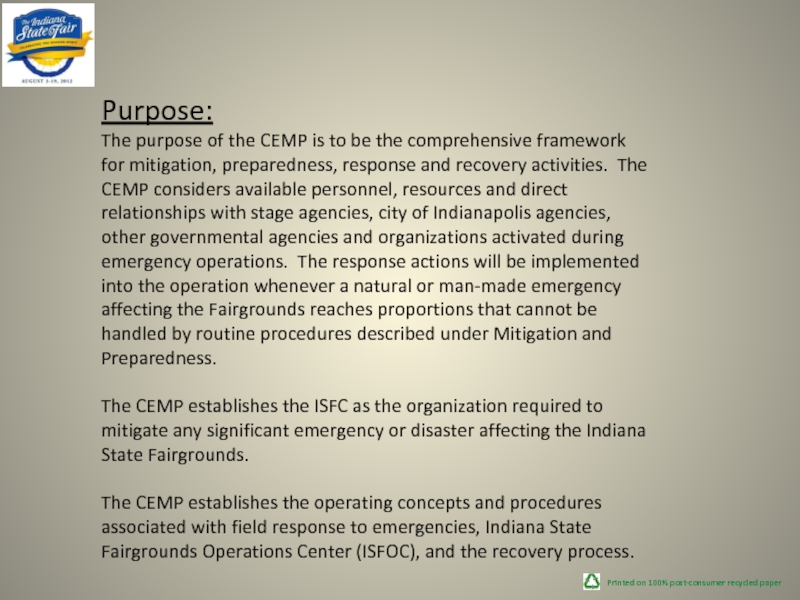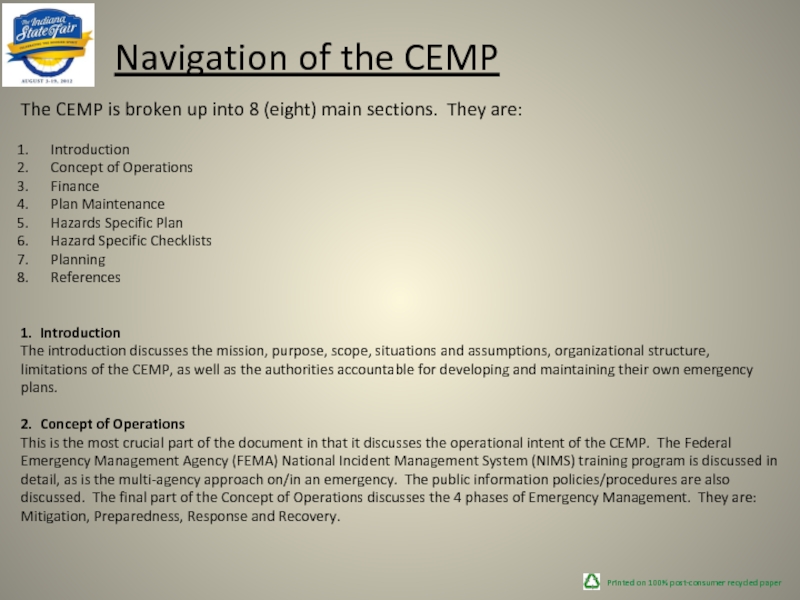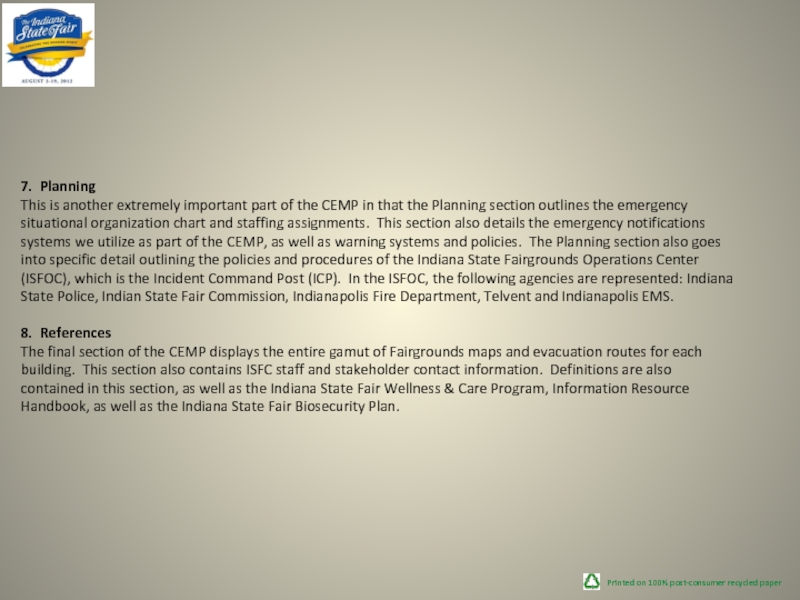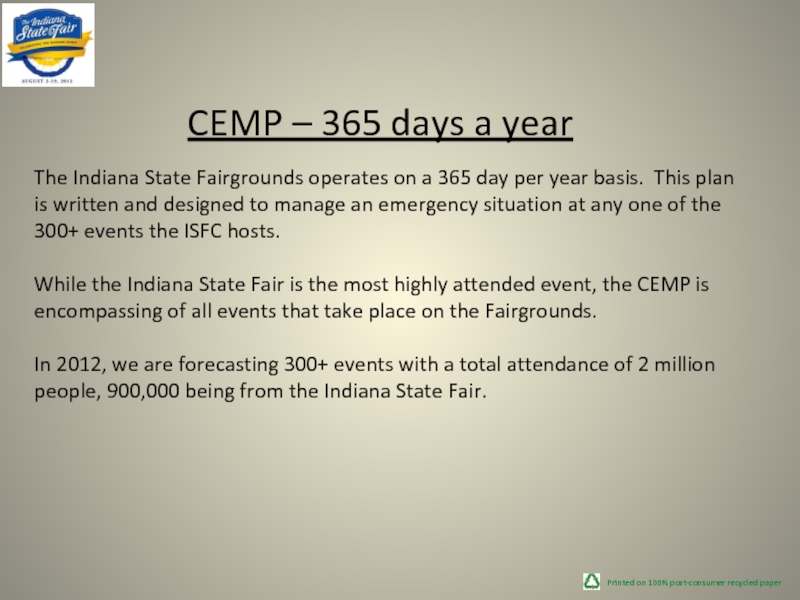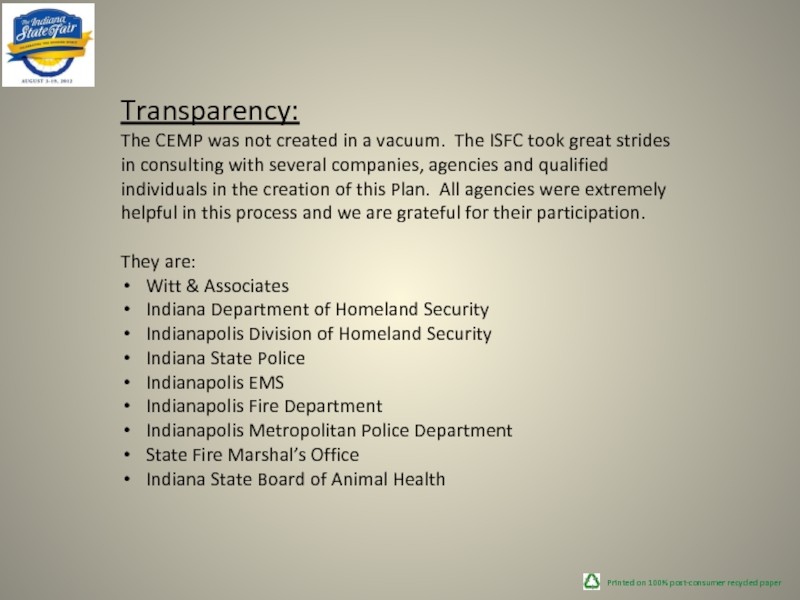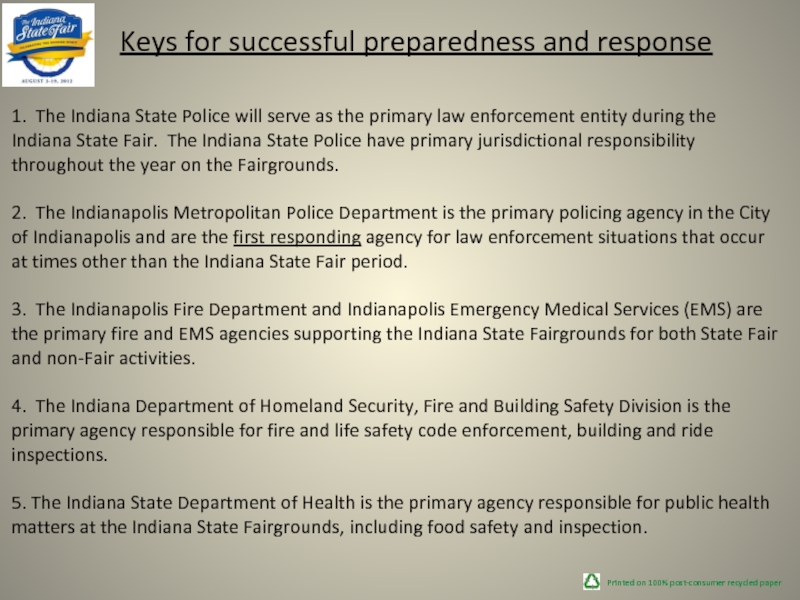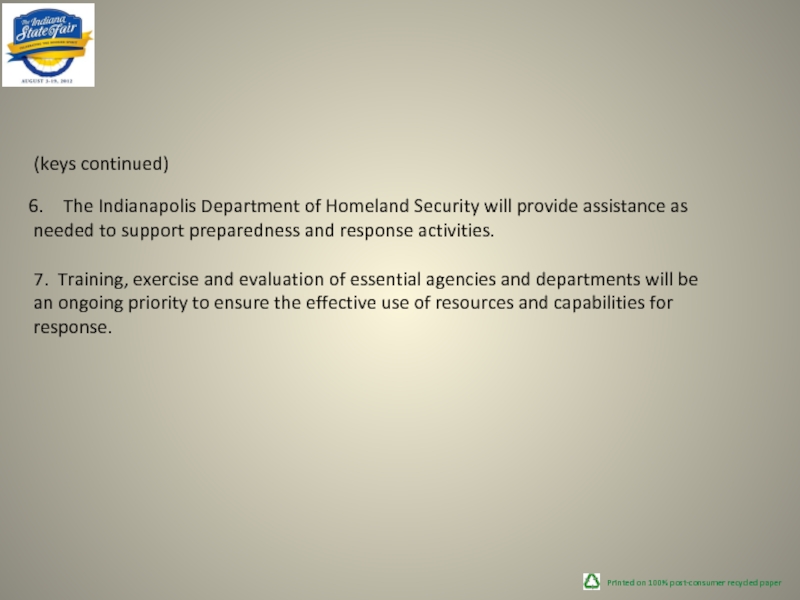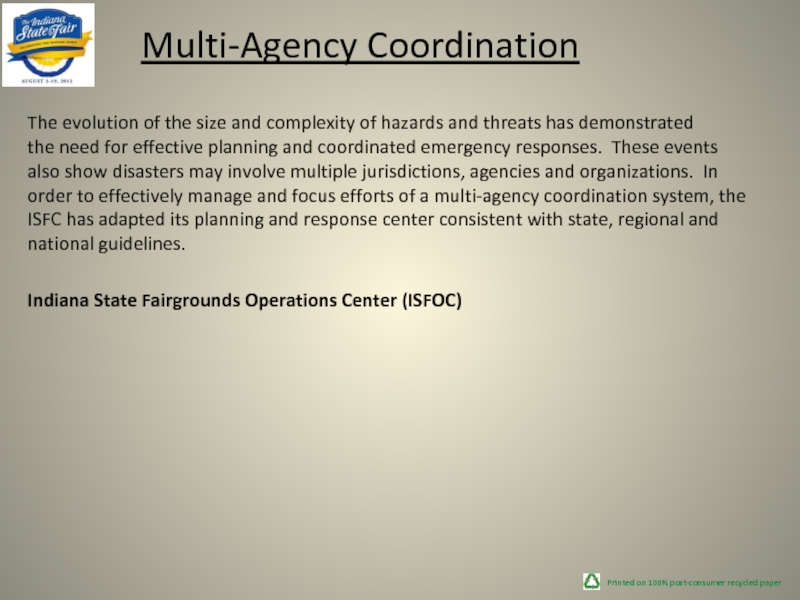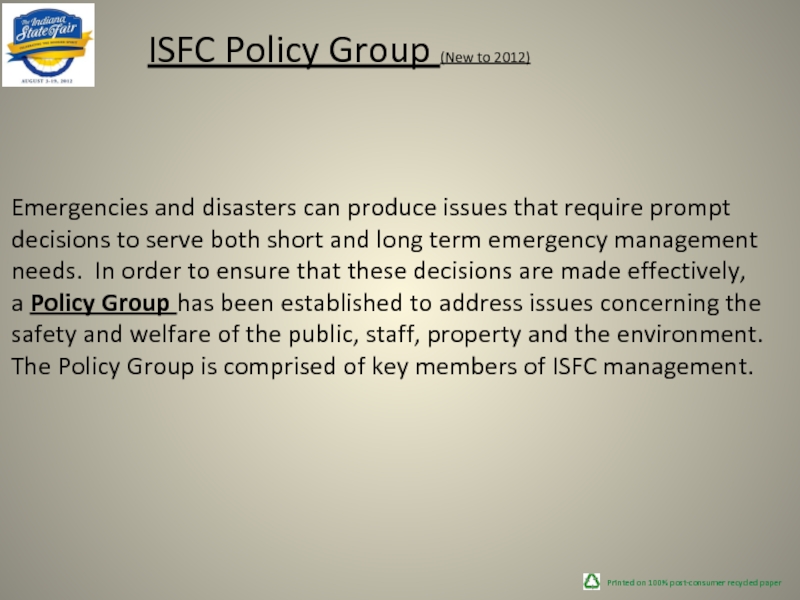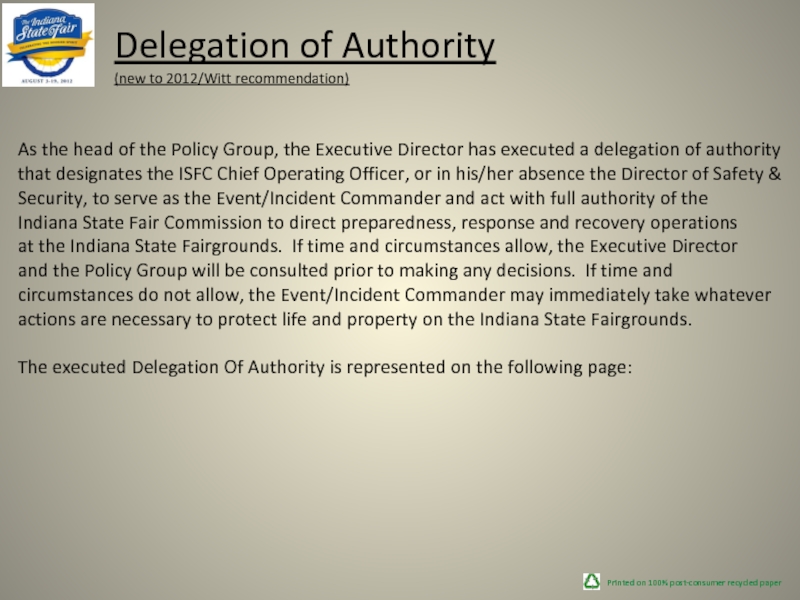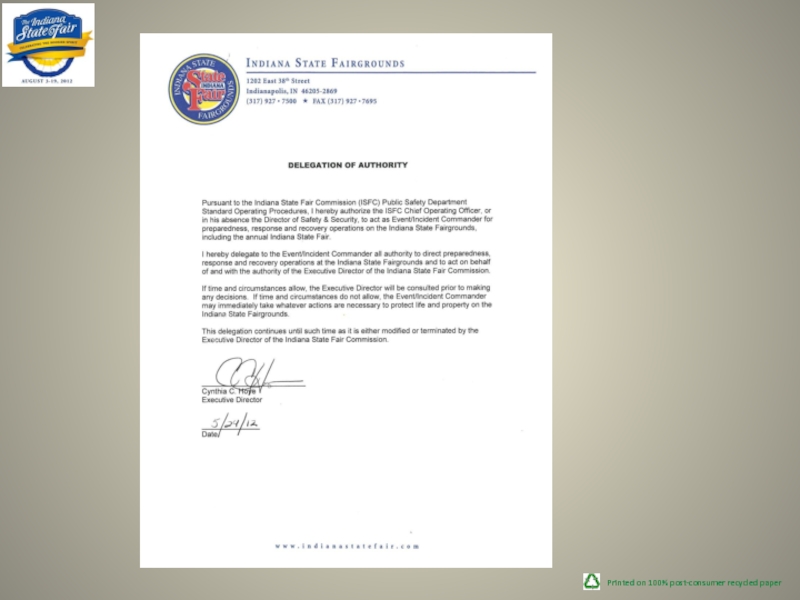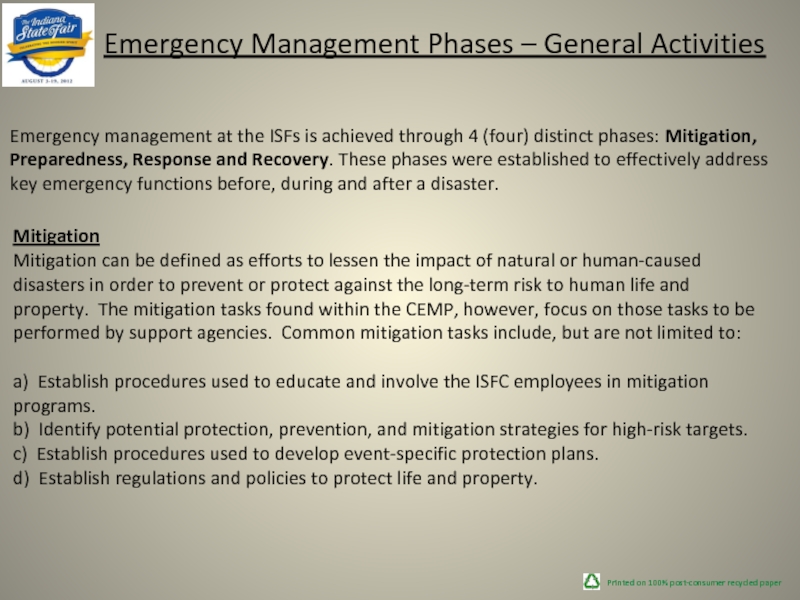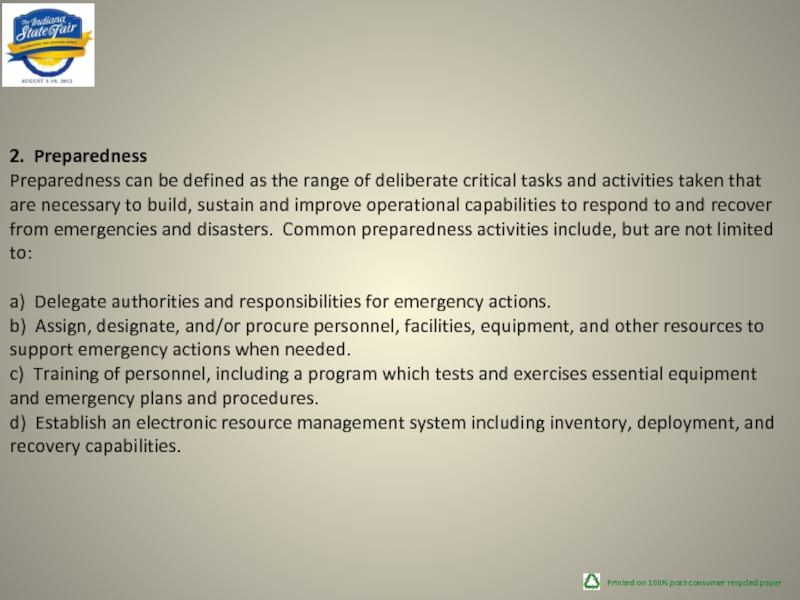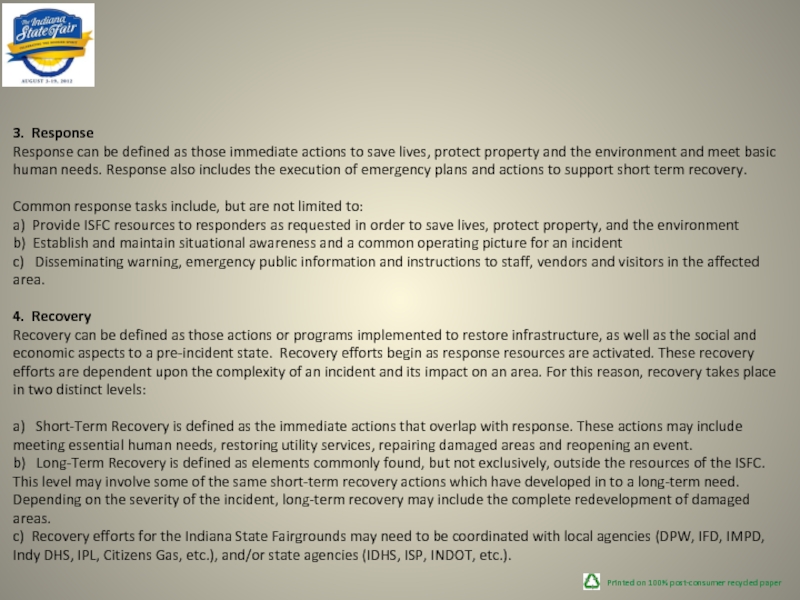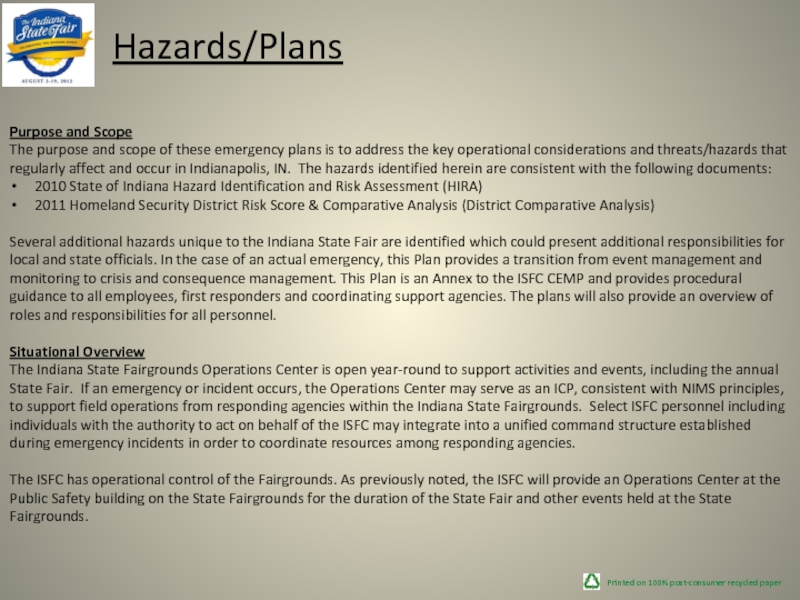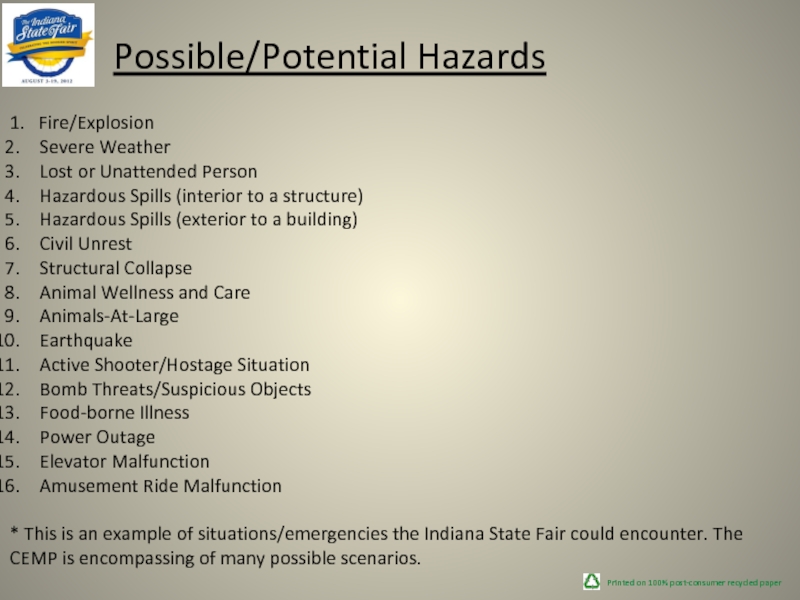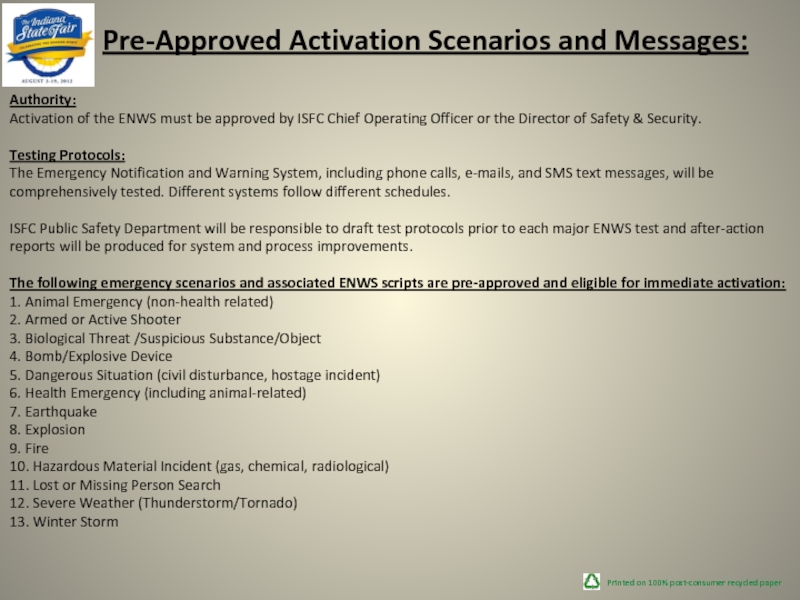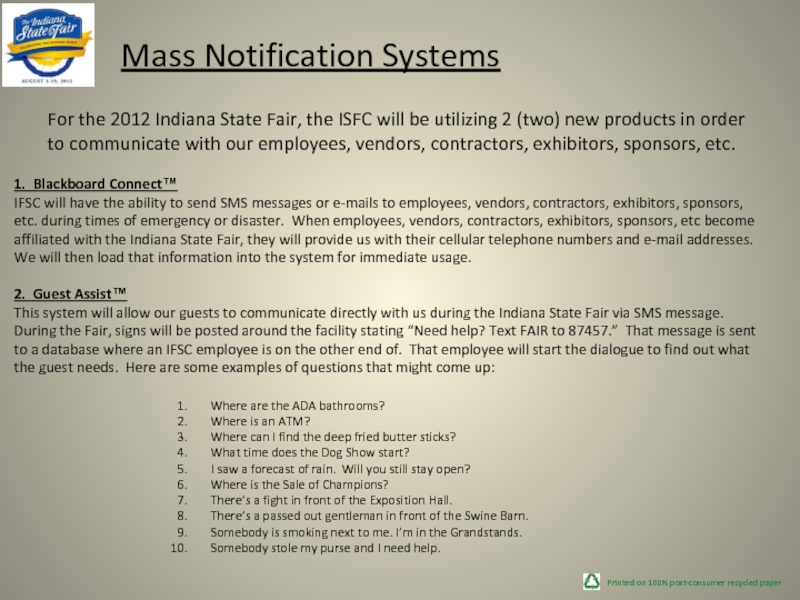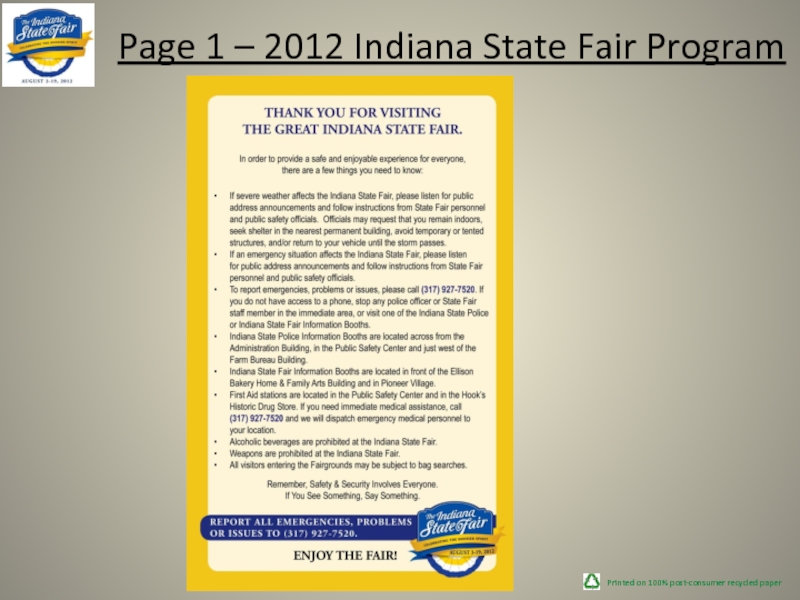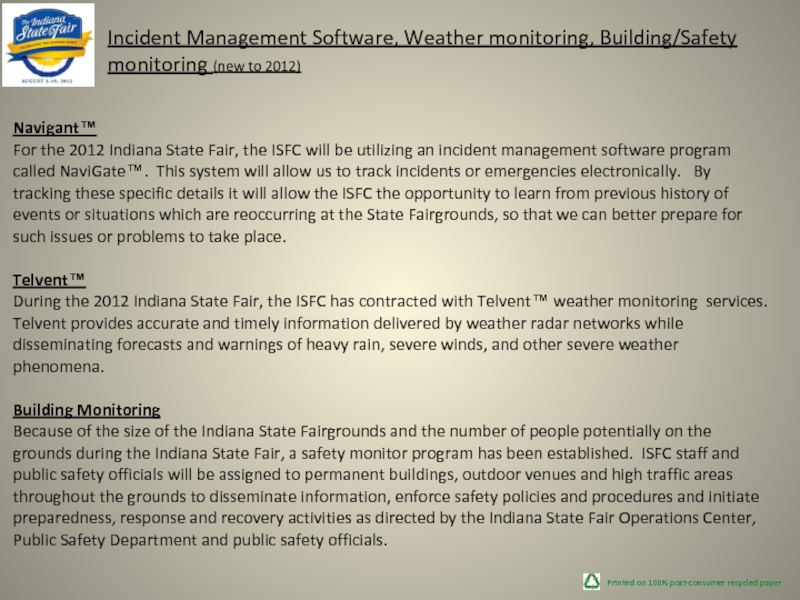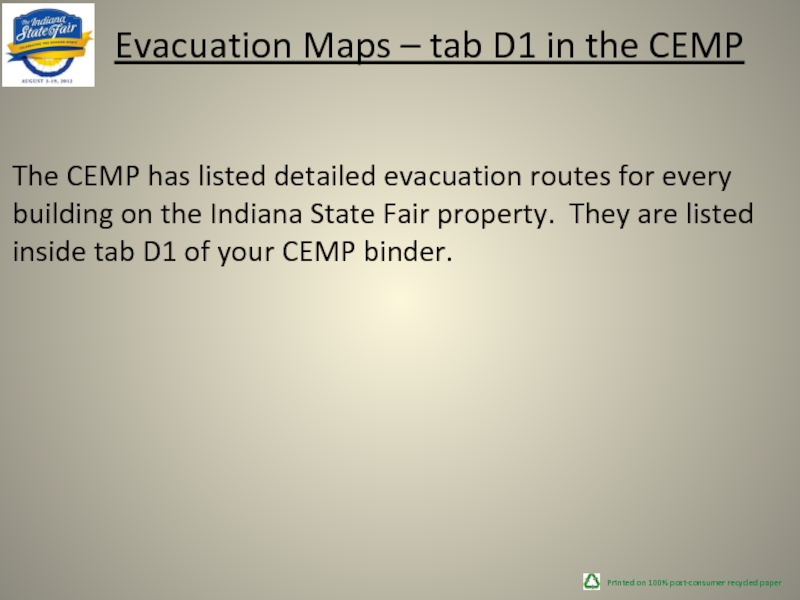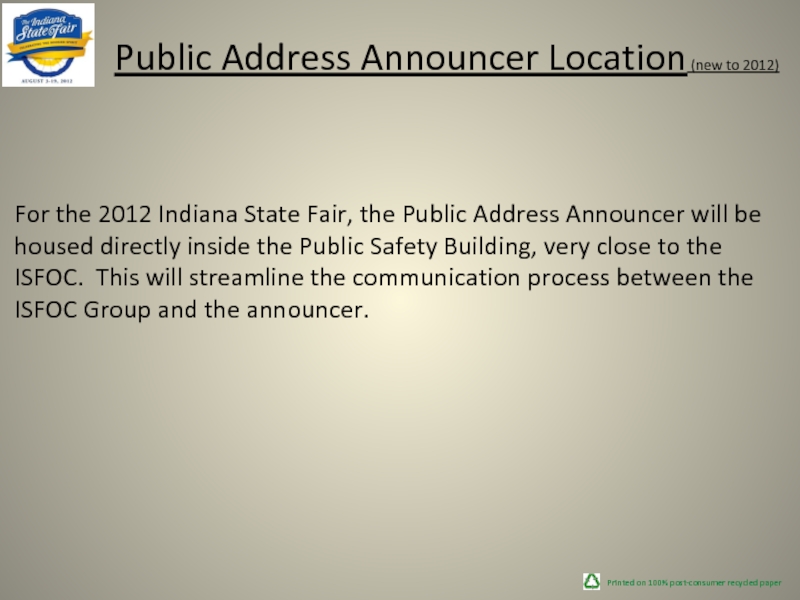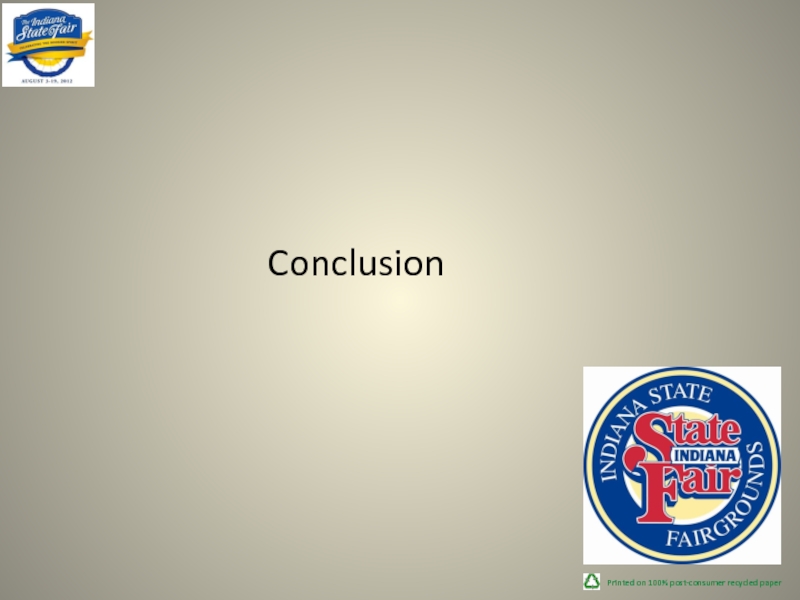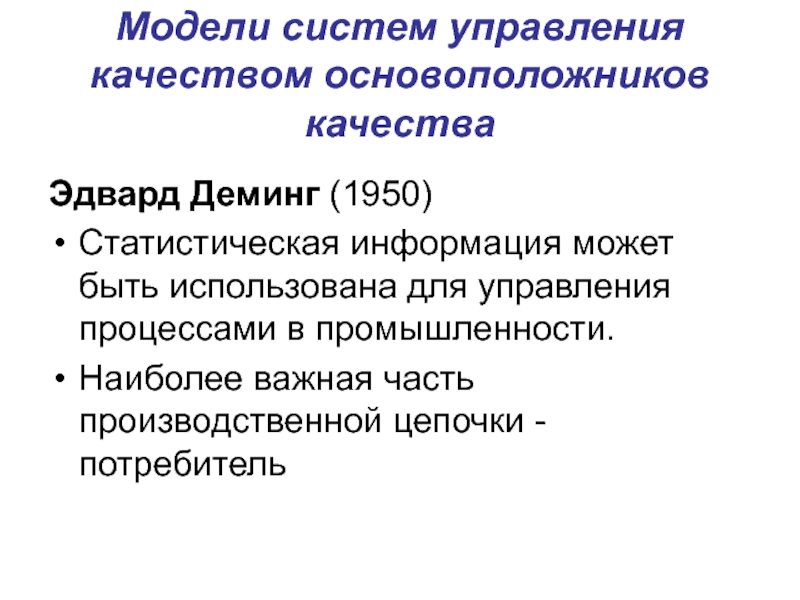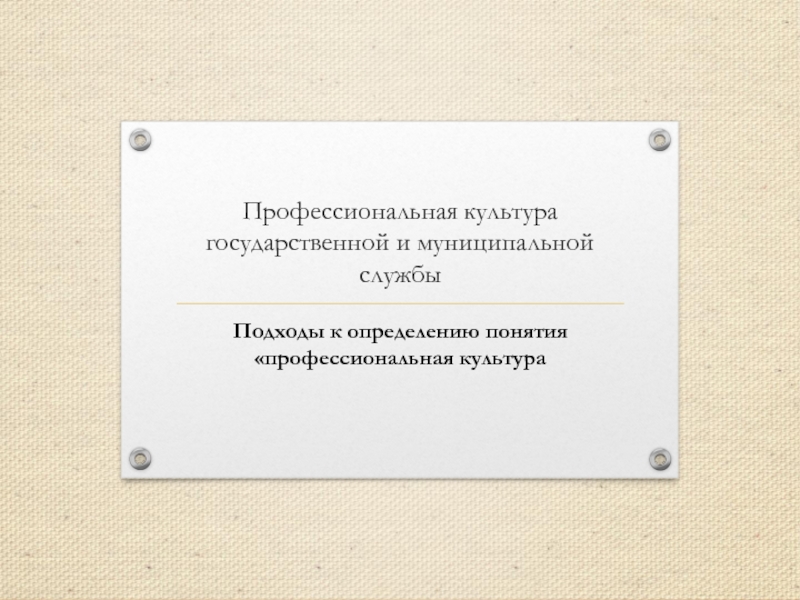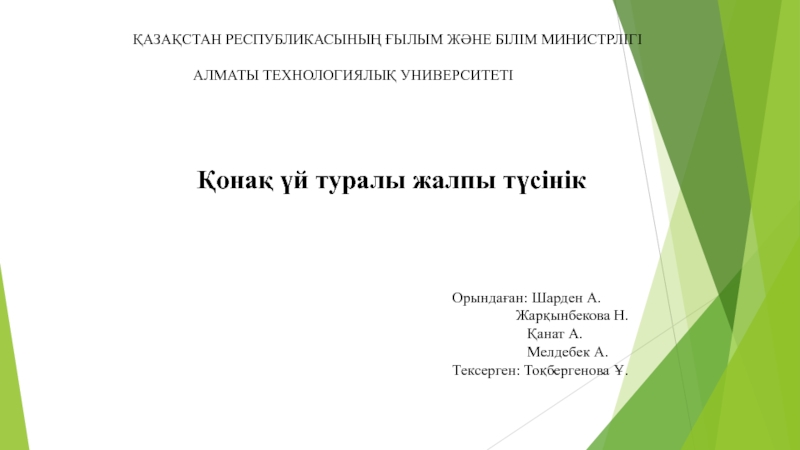- Главная
- Разное
- Дизайн
- Бизнес и предпринимательство
- Аналитика
- Образование
- Развлечения
- Красота и здоровье
- Финансы
- Государство
- Путешествия
- Спорт
- Недвижимость
- Армия
- Графика
- Культурология
- Еда и кулинария
- Лингвистика
- Английский язык
- Астрономия
- Алгебра
- Биология
- География
- Детские презентации
- Информатика
- История
- Литература
- Маркетинг
- Математика
- Медицина
- Менеджмент
- Музыка
- МХК
- Немецкий язык
- ОБЖ
- Обществознание
- Окружающий мир
- Педагогика
- Русский язык
- Технология
- Физика
- Философия
- Химия
- Шаблоны, картинки для презентаций
- Экология
- Экономика
- Юриспруденция
Comprehensive Emergency Management Plan Indiana State Fair Commission презентация
Содержание
- 1. Comprehensive Emergency Management Plan Indiana State Fair Commission
- 2. Printed on 100% post-consumer recycled paper
- 3. Printed on 100% post-consumer recycled paper
- 4. Printed on 100% post-consumer recycled paper
- 5. Printed on 100% post-consumer recycled paper
- 6. Printed on 100% post-consumer recycled paper
- 7. Printed on 100% post-consumer recycled paper
- 8. Printed on 100% post-consumer recycled paper
- 9. Printed on 100% post-consumer recycled paper
- 10. Printed on 100% post-consumer recycled paper
- 11. Printed on 100% post-consumer recycled paper
- 12. Printed on 100% post-consumer recycled paper
- 13. Printed on 100% post-consumer recycled paper
- 14. Printed on 100% post-consumer recycled paper
- 15. Printed on 100% post-consumer recycled paper
- 16. Printed on 100% post-consumer recycled paper Insert DOA here
- 17. Printed on 100% post-consumer recycled paper
- 18. Printed on 100% post-consumer recycled paper
- 19. Printed on 100% post-consumer recycled paper
- 20. Printed on 100% post-consumer recycled paper
- 21. Printed on 100% post-consumer recycled paper
- 22. Printed on 100% post-consumer recycled paper
- 23. Printed on 100% post-consumer recycled paper
- 24. Printed on 100% post-consumer recycled paper
- 25. Printed on 100% post-consumer recycled paper
- 26. Printed on 100% post-consumer recycled paper
- 27. Printed on 100% post-consumer recycled paper Page 1 – 2012 Indiana State Fair Program
- 28. Printed on 100% post-consumer recycled paper
- 29. Printed on 100% post-consumer recycled paper
- 30. Printed on 100% post-consumer recycled paper
- 31. Printed on 100% post-consumer recycled paper Conclusion
Слайд 1Comprehensive Emergency Management Plan
Indiana State Fair Commission
Thursday, June 14th, 2012
Printed
Слайд 2Printed on 100% post-consumer recycled paper
This Indiana State Fair Commission
We believe it is one of the most comprehensive public safety plans in the country today.
This document is in a final draft as of today, June 14th, 2012 – however it is a living document. When the ISFC sees the need for changes, revisions or improvements, we will make the necessary adjustments to the plan and reflect said changes in our operation immediately.
This CEMP is for the betterment of not only the Indiana State Fairgrounds and the state of Indiana, but public assembly facilities throughout the country.
Слайд 3Printed on 100% post-consumer recycled paper
CEMP Mission:
The mission of the
Слайд 4Printed on 100% post-consumer recycled paper
Purpose:
The purpose of the CEMP
The CEMP establishes the ISFC as the organization required to mitigate any significant emergency or disaster affecting the Indiana State Fairgrounds.
The CEMP establishes the operating concepts and procedures associated with field response to emergencies, Indiana State Fairgrounds Operations Center (ISFOC), and the recovery process.
Слайд 5Printed on 100% post-consumer recycled paper
Navigation of the CEMP
The CEMP
Introduction
Concept of Operations
Finance
Plan Maintenance
Hazards Specific Plan
Hazard Specific Checklists
Planning
References
1. Introduction
The introduction discusses the mission, purpose, scope, situations and assumptions, organizational structure, limitations of the CEMP, as well as the authorities accountable for developing and maintaining their own emergency plans.
2. Concept of Operations
This is the most crucial part of the document in that it discusses the operational intent of the CEMP. The Federal Emergency Management Agency (FEMA) National Incident Management System (NIMS) training program is discussed in detail, as is the multi-agency approach on/in an emergency. The public information policies/procedures are also discussed. The final part of the Concept of Operations discusses the 4 phases of Emergency Management. They are: Mitigation, Preparedness, Response and Recovery.
Слайд 6Printed on 100% post-consumer recycled paper
3. Finance
The finance section discusses
4. Plan Maintenance
The plan maintenance covers just that – it’s a regular maintenance protocol for the CEMP. It outlines who is responsible for maintaining the document as well as the frequency for which the document should be maintained. It also discusses testing, evaluation and corrective actions which need to take place, and how that corrective action can occur.
5. Hazards Specific Plan
In the CEMP we identify 16 potential hazards which pose a threat to the Indiana State Fairgrounds. In this section, we worked very closely with the Indiana Department of Homeland Security to not only identify these hazards, but also develop plans for each hazard. The specifics of each plan are encompassing the decision making process to identify if in fact a situation is a hazard, as well as how, when and why to implement the 4 phases of emergency management - Mitigation, Preparedness, Response and Recovery.
6. Hazard Specific Checklists
To accompany the Hazard Specific Plans, we have created checklists to go along with the plans. This is simply a check and balance system as the plan is being implemented for each individual hazard, ensuring accountability for that specific hazard. There is one checklist for each of the 16 hazards.
Слайд 7Printed on 100% post-consumer recycled paper
7. Planning
This is another extremely
8. References
The final section of the CEMP displays the entire gamut of Fairgrounds maps and evacuation routes for each building. This section also contains ISFC staff and stakeholder contact information. Definitions are also contained in this section, as well as the Indiana State Fair Wellness & Care Program, Information Resource Handbook, as well as the Indiana State Fair Biosecurity Plan.
Слайд 8Printed on 100% post-consumer recycled paper
CEMP – 365 days a
The Indiana State Fairgrounds operates on a 365 day per year basis. This plan is written and designed to manage an emergency situation at any one of the 300+ events the ISFC hosts.
While the Indiana State Fair is the most highly attended event, the CEMP is encompassing of all events that take place on the Fairgrounds.
In 2012, we are forecasting 300+ events with a total attendance of 2 million people, 900,000 being from the Indiana State Fair.
Слайд 9Printed on 100% post-consumer recycled paper
Transparency:
The CEMP was not created
They are:
Witt & Associates
Indiana Department of Homeland Security
Indianapolis Division of Homeland Security
Indiana State Police
Indianapolis EMS
Indianapolis Fire Department
Indianapolis Metropolitan Police Department
State Fire Marshal’s Office
Indiana State Board of Animal Health
Слайд 10Printed on 100% post-consumer recycled paper
Keys for successful preparedness and
1. The Indiana State Police will serve as the primary law enforcement entity during the Indiana State Fair. The Indiana State Police have primary jurisdictional responsibility throughout the year on the Fairgrounds.
2. The Indianapolis Metropolitan Police Department is the primary policing agency in the City of Indianapolis and are the first responding agency for law enforcement situations that occur at times other than the Indiana State Fair period.
3. The Indianapolis Fire Department and Indianapolis Emergency Medical Services (EMS) are the primary fire and EMS agencies supporting the Indiana State Fairgrounds for both State Fair and non-Fair activities.
4. The Indiana Department of Homeland Security, Fire and Building Safety Division is the primary agency responsible for fire and life safety code enforcement, building and ride inspections.
5. The Indiana State Department of Health is the primary agency responsible for public health matters at the Indiana State Fairgrounds, including food safety and inspection.
Слайд 11Printed on 100% post-consumer recycled paper
The Indianapolis Department of Homeland
needed to support preparedness and response activities.
7. Training, exercise and evaluation of essential agencies and departments will be an ongoing priority to ensure the effective use of resources and capabilities for response.
(keys continued)
Слайд 12Printed on 100% post-consumer recycled paper
The ISFC is proud to
National Incident Management System (NIMS).
NIMS provides a systematic, proactive approach to guide departments and agencies at all levels of government, nongovernmental organizations, and the private sector to work seamlessly to prevent, protect against, respond to, recover from, and mitigate the effects of incidents, regardless of cause, size, location, or complexity, in order to reduce the loss of life and property and harm to the environment.
ISFC employees are required to take NIMS courses based on their position, on an annual basis.
As of today, June 14th, 2012, we are excited to report that all required ISFC employees have taken and passed their required courses.
ISFC & NIMS
Слайд 13Printed on 100% post-consumer recycled paper
Multi-Agency Coordination
The evolution of the
the need for effective planning and coordinated emergency responses. These events also show disasters may involve multiple jurisdictions, agencies and organizations. In order to effectively manage and focus efforts of a multi-agency coordination system, the ISFC has adapted its planning and response center consistent with state, regional and national guidelines.
Indiana State Fairgrounds Operations Center (ISFOC)
Слайд 14Printed on 100% post-consumer recycled paper
ISFC Policy Group (New to
Emergencies and disasters can produce issues that require prompt
decisions to serve both short and long term emergency management
needs. In order to ensure that these decisions are made effectively,
a Policy Group has been established to address issues concerning the
safety and welfare of the public, staff, property and the environment.
The Policy Group is comprised of key members of ISFC management.
Слайд 15Printed on 100% post-consumer recycled paper
Delegation of Authority
(new to
As the head of the Policy Group, the Executive Director has executed a delegation of authority
that designates the ISFC Chief Operating Officer, or in his/her absence the Director of Safety &
Security, to serve as the Event/Incident Commander and act with full authority of the
Indiana State Fair Commission to direct preparedness, response and recovery operations
at the Indiana State Fairgrounds. If time and circumstances allow, the Executive Director
and the Policy Group will be consulted prior to making any decisions. If time and circumstances do not allow, the Event/Incident Commander may immediately take whatever actions are necessary to protect life and property on the Indiana State Fairgrounds.
The executed Delegation Of Authority is represented on the following page:
Слайд 17Printed on 100% post-consumer recycled paper
Standard Operating Procedures (SOPs)
The ISFC
All of the CEMP SOPs are relevant in nature either to specific hazards that could take place or large-scale decisions affecting the Indiana State Fairgrounds.
Слайд 18Printed on 100% post-consumer recycled paper
Revised Contract/Rider Language (new to
The ISFC has a standard contract/rider which each event producer/promoter must execute prior to their event from occurring on the Indiana State Fairgrounds.
This contract/rider outlines specific language related to the IFSC having the exclusive & sole responsibility/decision making ability when determining the appropriate time to postpone, evacuate or cancel an event due to any situation deemed necessary by the ISFC.
Слайд 19Printed on 100% post-consumer recycled paper
Emergency Management Phases – General
Emergency management at the ISFs is achieved through 4 (four) distinct phases: Mitigation, Preparedness, Response and Recovery. These phases were established to effectively address key emergency functions before, during and after a disaster.
Mitigation
Mitigation can be defined as efforts to lessen the impact of natural or human-caused disasters in order to prevent or protect against the long-term risk to human life and property. The mitigation tasks found within the CEMP, however, focus on those tasks to be performed by support agencies. Common mitigation tasks include, but are not limited to:
a) Establish procedures used to educate and involve the ISFC employees in mitigation programs.
b) Identify potential protection, prevention, and mitigation strategies for high-risk targets.
c) Establish procedures used to develop event-specific protection plans.
d) Establish regulations and policies to protect life and property.
Слайд 20Printed on 100% post-consumer recycled paper
2. Preparedness
Preparedness can be defined
a) Delegate authorities and responsibilities for emergency actions.
b) Assign, designate, and/or procure personnel, facilities, equipment, and other resources to support emergency actions when needed.
c) Training of personnel, including a program which tests and exercises essential equipment and emergency plans and procedures.
d) Establish an electronic resource management system including inventory, deployment, and recovery capabilities.
Слайд 21Printed on 100% post-consumer recycled paper
3. Response
Response can be defined
Common response tasks include, but are not limited to:
a) Provide ISFC resources to responders as requested in order to save lives, protect property, and the environment
b) Establish and maintain situational awareness and a common operating picture for an incident
c) Disseminating warning, emergency public information and instructions to staff, vendors and visitors in the affected area.
4. Recovery
Recovery can be defined as those actions or programs implemented to restore infrastructure, as well as the social and economic aspects to a pre-incident state. Recovery efforts begin as response resources are activated. These recovery efforts are dependent upon the complexity of an incident and its impact on an area. For this reason, recovery takes place in two distinct levels:
a) Short-Term Recovery is defined as the immediate actions that overlap with response. These actions may include meeting essential human needs, restoring utility services, repairing damaged areas and reopening an event.
b) Long-Term Recovery is defined as elements commonly found, but not exclusively, outside the resources of the ISFC. This level may involve some of the same short-term recovery actions which have developed in to a long-term need. Depending on the severity of the incident, long-term recovery may include the complete redevelopment of damaged areas.
c) Recovery efforts for the Indiana State Fairgrounds may need to be coordinated with local agencies (DPW, IFD, IMPD, Indy DHS, IPL, Citizens Gas, etc.), and/or state agencies (IDHS, ISP, INDOT, etc.).
Слайд 22Printed on 100% post-consumer recycled paper
Hazards/Plans
Purpose and Scope
The
2010 State of Indiana Hazard Identification and Risk Assessment (HIRA)
2011 Homeland Security District Risk Score & Comparative Analysis (District Comparative Analysis)
Several additional hazards unique to the Indiana State Fair are identified which could present additional responsibilities for local and state officials. In the case of an actual emergency, this Plan provides a transition from event management and monitoring to crisis and consequence management. This Plan is an Annex to the ISFC CEMP and provides procedural guidance to all employees, first responders and coordinating support agencies. The plans will also provide an overview of roles and responsibilities for all personnel.
Situational Overview
The Indiana State Fairgrounds Operations Center is open year-round to support activities and events, including the annual State Fair. If an emergency or incident occurs, the Operations Center may serve as an ICP, consistent with NIMS principles, to support field operations from responding agencies within the Indiana State Fairgrounds. Select ISFC personnel including individuals with the authority to act on behalf of the ISFC may integrate into a unified command structure established during emergency incidents in order to coordinate resources among responding agencies.
The ISFC has operational control of the Fairgrounds. As previously noted, the ISFC will provide an Operations Center at the Public Safety building on the State Fairgrounds for the duration of the State Fair and other events held at the State Fairgrounds.
Слайд 23Printed on 100% post-consumer recycled paper
1. Fire/Explosion
Severe Weather
Lost
Hazardous Spills (interior to a structure)
Hazardous Spills (exterior to a building)
Civil Unrest
Structural Collapse
Animal Wellness and Care
Animals-At-Large
Earthquake
Active Shooter/Hostage Situation
Bomb Threats/Suspicious Objects
Food-borne Illness
Power Outage
Elevator Malfunction
Amusement Ride Malfunction
* This is an example of situations/emergencies the Indiana State Fair could encounter. The CEMP is encompassing of many possible scenarios.
Possible/Potential Hazards
Слайд 24Printed on 100% post-consumer recycled paper
Emergency Notifications and Warning Systems
Policies and Procedures Guide
Responsibility
The ISFC Public Safety Department has the primary responsibility for alerting individuals on the Fairgrounds. Alerts are to inform people of current and foreseen threats. The Emergency Notification and Warning System (ENWS) has various components such as the mass notification system that distributes emergency messages via phone, text and email. The ISFC Public Safety Department will be responsible for the use of the system in accordance with this guide. The Public Safety Department will also be responsible for reviewing and publishing a revised guide annually.
Available Emergency Notification and Warning Systems
The ISFC Emergency Notification and Warning System consist of the following communication methods, listed in order of effectiveness (activation and delivery speed, audience reach, etc.).
1. NOAA Weather Radio
2. Contract Weather Service
3. Mass Notification System
4. Public Address System
5. UHF and 800 MHz Radio System
6. Social Networking sites (i.e. Twitter, Facebook, Foursquare)
7. Media News Release / Press Conference
8. Local Television Stations
9. Local Radio Stations
Слайд 25Printed on 100% post-consumer recycled paper
Authority:
Activation of the ENWS
Testing Protocols:
The Emergency Notification and Warning System, including phone calls, e-mails, and SMS text messages, will be comprehensively tested. Different systems follow different schedules.
ISFC Public Safety Department will be responsible to draft test protocols prior to each major ENWS test and after-action reports will be produced for system and process improvements.
The following emergency scenarios and associated ENWS scripts are pre-approved and eligible for immediate activation:
1. Animal Emergency (non-health related)
2. Armed or Active Shooter
3. Biological Threat /Suspicious Substance/Object
4. Bomb/Explosive Device
5. Dangerous Situation (civil disturbance, hostage incident)
6. Health Emergency (including animal-related)
7. Earthquake
8. Explosion
9. Fire
10. Hazardous Material Incident (gas, chemical, radiological)
11. Lost or Missing Person Search
12. Severe Weather (Thunderstorm/Tornado)
13. Winter Storm
Pre-Approved Activation Scenarios and Messages:
Слайд 26Printed on 100% post-consumer recycled paper
Mass Notification Systems
For the 2012
to communicate with our employees, vendors, contractors, exhibitors, sponsors, etc.
1. Blackboard Connect™
IFSC will have the ability to send SMS messages or e-mails to employees, vendors, contractors, exhibitors, sponsors, etc. during times of emergency or disaster. When employees, vendors, contractors, exhibitors, sponsors, etc become affiliated with the Indiana State Fair, they will provide us with their cellular telephone numbers and e-mail addresses. We will then load that information into the system for immediate usage.
2. Guest Assist™
This system will allow our guests to communicate directly with us during the Indiana State Fair via SMS message. During the Fair, signs will be posted around the facility stating “Need help? Text FAIR to 87457.” That message is sent to a database where an IFSC employee is on the other end of. That employee will start the dialogue to find out what the guest needs. Here are some examples of questions that might come up:
Where are the ADA bathrooms?
Where is an ATM?
Where can I find the deep fried butter sticks?
What time does the Dog Show start?
I saw a forecast of rain. Will you still stay open?
Where is the Sale of Champions?
There’s a fight in front of the Exposition Hall.
There’s a passed out gentleman in front of the Swine Barn.
Somebody is smoking next to me. I’m in the Grandstands.
Somebody stole my purse and I need help.
Слайд 28Printed on 100% post-consumer recycled paper
Incident Management Software, Weather monitoring,
monitoring (new to 2012)
Navigant™
For the 2012 Indiana State Fair, the ISFC will be utilizing an incident management software program called NaviGate™. This system will allow us to track incidents or emergencies electronically. By tracking these specific details it will allow the ISFC the opportunity to learn from previous history of events or situations which are reoccurring at the State Fairgrounds, so that we can better prepare for such issues or problems to take place.
Telvent™
During the 2012 Indiana State Fair, the ISFC has contracted with Telvent™ weather monitoring services. Telvent provides accurate and timely information delivered by weather radar networks while disseminating forecasts and warnings of heavy rain, severe winds, and other severe weather phenomena.
Building Monitoring
Because of the size of the Indiana State Fairgrounds and the number of people potentially on the grounds during the Indiana State Fair, a safety monitor program has been established. ISFC staff and public safety officials will be assigned to permanent buildings, outdoor venues and high traffic areas throughout the grounds to disseminate information, enforce safety policies and procedures and initiate
preparedness, response and recovery activities as directed by the Indiana State Fair Operations Center, Public Safety Department and public safety officials.
Слайд 29Printed on 100% post-consumer recycled paper
Evacuation Maps – tab D1
The CEMP has listed detailed evacuation routes for every
building on the Indiana State Fair property. They are listed
inside tab D1 of your CEMP binder.
Слайд 30Printed on 100% post-consumer recycled paper
Public Address Announcer Location (new
For the 2012 Indiana State Fair, the Public Address Announcer will be
housed directly inside the Public Safety Building, very close to the
ISFOC. This will streamline the communication process between the
ISFOC Group and the announcer.
